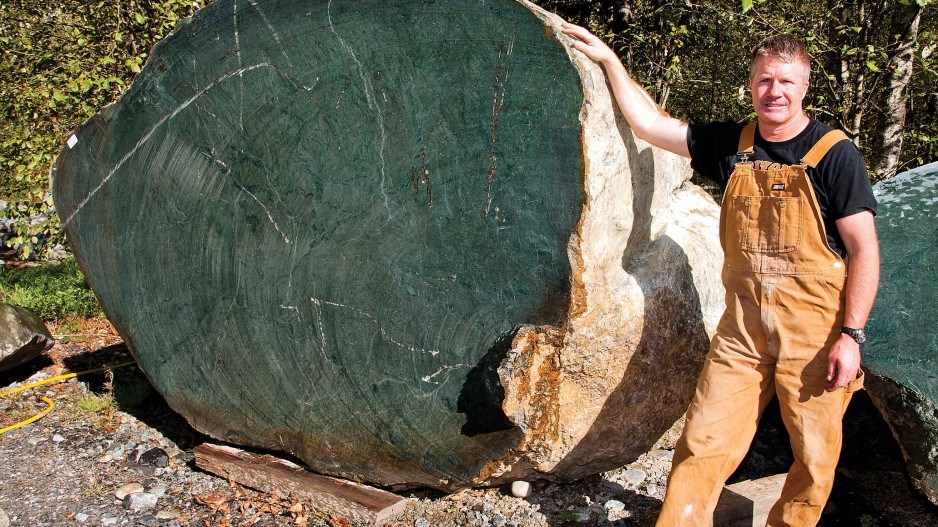BC’s top mining commodities – gold, copper and metallurgical coal – are in the dumpster, thanks in no small part to lower demand in China.
But there’s one B.C. commodity that China can’t seem to get enough of: jade.
The demand for the green gemstone in China continues to grow, and B.C. happens to be one of the world’s biggest nephrite jade producers.
That might explain why Chinese investors and junior exploration companies have been falling all over each other in recent years trying to snap up jade mineral claims.
“The market’s very hot right now,” said Cassiar Jade Contracting founder and partner Tony Ritter, who is acknowledged within the industry as one of B.C.’s jade mining pioneers.
B.C. jade is so hot that there’s even a new reality TV show about it.
Jade Fever, which premiered recently on the Discovery Channel, focuses on Claudia and Robin Bunce, who have been in the jade business for decades and live in a tiny hamlet near the Yukon border with a name that sounds like it belongs in the land of Oz: Jade City.
Up until about 2011, almost all of the jade mining in B.C. was done by a handful of private operators, including Ritter’s Cassiar Jade, the Bunces and Kirk Makepeace’s Jade West.
In 2011, Jade West’s claims were bought out by Shao Long Li, a Chinese immigrant who formed Green Mountain Gemstones, which now owns four operating jade quarries. The company plans to open B.C.’s first jade retail store in Richmond in November.
More recently, in January, Zimtu Capital Corp. (TSX-V:ZC) leapt into the jade space by spinning Electra Gold, a junior mining company, into Electra Stone Ltd. (TSX-V:ELT), which has acquired six jade claims in B.C.
None of the claims is producing jade yet. But in an attempt to get a toehold in the market, it bought 18 tonnes of B.C. jade and recently shipped it to Shanghai.
“The goal here is not just to sell the jade and capture some margin and have a business case for it, it’s also to expand the market as a whole,” said Tyler Lowes, Electra Stone’s corporate development manager.
There are two kinds of jade. Jadeite is the most valued and is used mostly in jewelry. Myanmar is the biggest producer.
The nephrite jade found in B.C. is more abundant. It too is used to make jewelry, but it’s also used to make sculptures, and there is even a growing market for the lower-quality stuff for industrial and household products such as sinks and countertops.
In China, jade is treasured the way gold is treasured in India and is often passed down as family heirlooms. The growing affluence of China’s middle class has been driving the demand for jade in recent years.
“The price increase has been going up for the last 10 years,” said Charles Lee, operations manager for Green Mountain Gemstones.
Claudia Bunce, whose father was a jade miner, thinks the demand for B.C. jade from China has more to do with access than with affluence in China. Eased travel restrictions over the last decade have allowed more Chinese buyers and tourists to travel to B.C. to buy jade.They have also allowed more Chinese investors to buy up jade properties and business ventures.
“It’s really hard to stake jade claims because they’re staking everything,” she said.
There’s little question that the market for B.C. nephrite jade is growing. Every year, in October, Cassiar Jade – B.C.’s biggest producer – holds a one-day auction that brings about 150 jade buyers and artisans from China and Taiwan.
And in Jade City, the Bunce family’s Cassiar Mountain Jade Store – located on the Stewart-Cassiar Highway near the Yukon – can see up to 500 tourists per day walk through the doors.
At the end of October, Claudia Bunce will travel to China with Premier Christy Clark as part of a trade mission and will be celebrating the opening of her company’s first jade store in Beijing.
The most productive jade deposits tend to be clustered in the Dease Lake area, just south of the Yukon border. While it has been profitable for private operators, profitability for publicly traded companies staking jade claims might be more of a challenge.
Many junior exploration companies that failed at gold have been jumping into flavour-of-the-month commodities, and jade might be just the latest, according to Mickey Fulp, who publishes the Mercenary Geologist.
“People who have a failed company, they’ll run into it and try to make a go of it,” Fulp said. “Ninety-five per cent will fail.”
One of the problems for a public company may be getting investors willing to bet on something that can be hard to value. Finding jade is even more of a hit-and-miss venture than gold.
“It really is a treasure hunt,” Bunce said.
Unlike precious metals, there is no standardized pricing for jade. Its value is in the eye of the beholder. Nephrite jade can range in value from $5 to $1,000 per kilogram.
“It’s a luxury stone and it’s totally quality-based,” said Ritter, “so it’s hard to say how much jade is in any one deposit.”
And as Fulp points out, nephrite jade is not that rare. It is found elsewhere in the world, although B.C. is currently the biggest producer. Moreover, there are only two big markets for jade: China and Taiwan.
“I would seriously doubt if a public company can succeed because it’s a small-demand thing,” Fulp said.
Although the demand is growing, Lee admits the nephrite jade market is small compared with other B.C. commodities. He said the market for B.C. jade is estimated to be worth between $40 million and $50 million.




